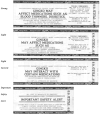A point-of-sale communications campaign to provide consumers safety information on drug-dietary supplement interactions: a pilot study
- PMID: 23356591
- PMCID: PMC3767765
- DOI: 10.1080/10410236.2012.713777
A point-of-sale communications campaign to provide consumers safety information on drug-dietary supplement interactions: a pilot study
Abstract
Concurrent use of dietary supplements with over-the-counter and prescription pharmaceuticals has become increasingly common, and with this trend, so has the incidence of adverse drug-supplement interactions. In the current market, consumers have no way to distinguish between safe and potentially harmful supplements. Thus, the primary objective of this study was to test the hypothesis that messages designed to increase consumers' awareness of potential health risks of concurrent use of dietary supplements with over-the-counter and prescription pharmaceuticals would promote further consideration and action, as evidenced by (a) seeking additional information from an authoritative source or qualified health care professional and (b) changing dietary supplement usage patterns. To test this hypothesis, an innovative consumer information delivery system, referred to as the Buyer Information Network (BuyIN), was utilized. BuyIN uses currently available, Web-enabled point-of-sale (POS) technology to provide up-to-date, evidence-based, health- and safety-related messages to consumers at the retail checkout counter. Results showed that more than one-fourth (27.1%) of consumers (n = 199) who purchased targeted items reported they were aware of the messages. Of this subgroup of aware consumers, 11.2% reported that they sought additional information from a physician or pharmacist, 11.5% reported that they visited the website listed on the coupon, and 10.5% indicated that they changed their dietary supplement usage patterns as a result of the messages. Future research should include a large-scale study of a fully implemented and capable system at multiple test sites around the country, including investigating the utility of BuyIN in different retail settings.
Figures
References
-
- Andrepont E, Cullen KW, Taylor WC. The use of point-of-sale machines in school cafeterias as a method of parental influence over child lunch food choices. Journal of School Health. 2011;81:239–243. - PubMed
-
- Ashar BH. The dietary supplement health and education act: Time for a reassessment: Comment on” acute selenium toxicity associated with a dietary supplement”. Archives of Internal Medicine. 2010;170:261. - PubMed
-
- Bent S, Ko R. Commonly used herbal medicines in the United States: A review. The American Journal of Medicine. 2004;116:478–485. - PubMed
-
- Bressler R. Herb–drug interactions. Geriatrics. 2005;60:30–33. - PubMed
-
- Corcoran N. Communicating health: Strategies for health promotion. Sage; London: 2007. Theories and models in communicating health messages; pp. 5–31.
Publication types
MeSH terms
Grants and funding
LinkOut - more resources
Full Text Sources
Other Literature Sources
Medical

